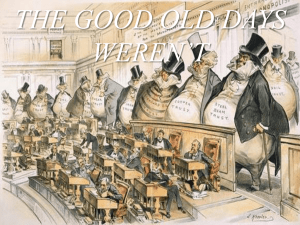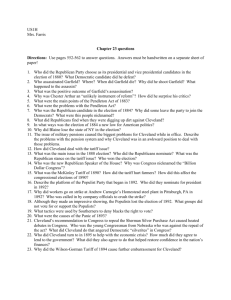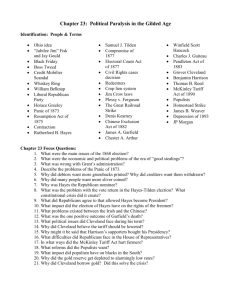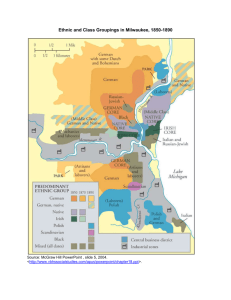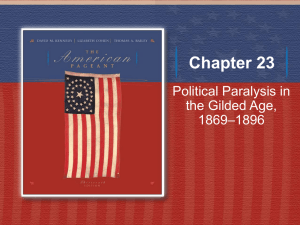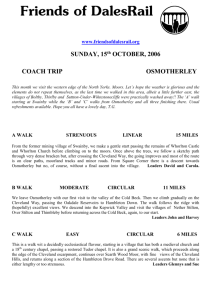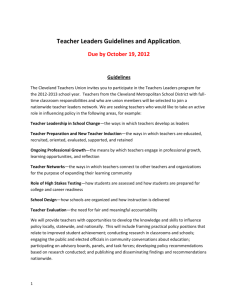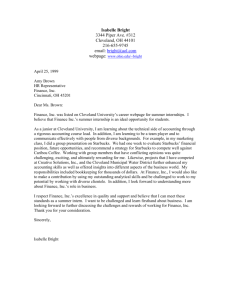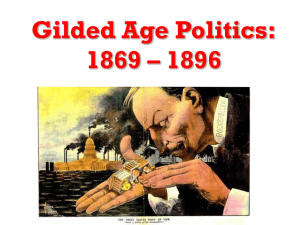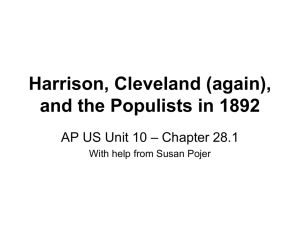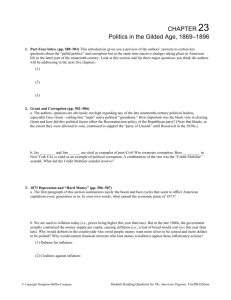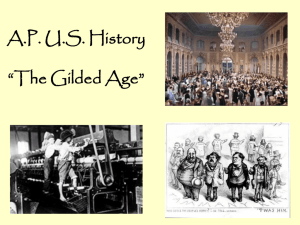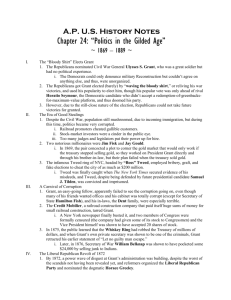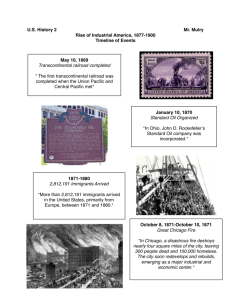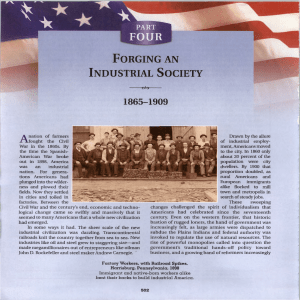Type Your Name: ___ Chapter 23: Political Paralysis in the Gilded
advertisement
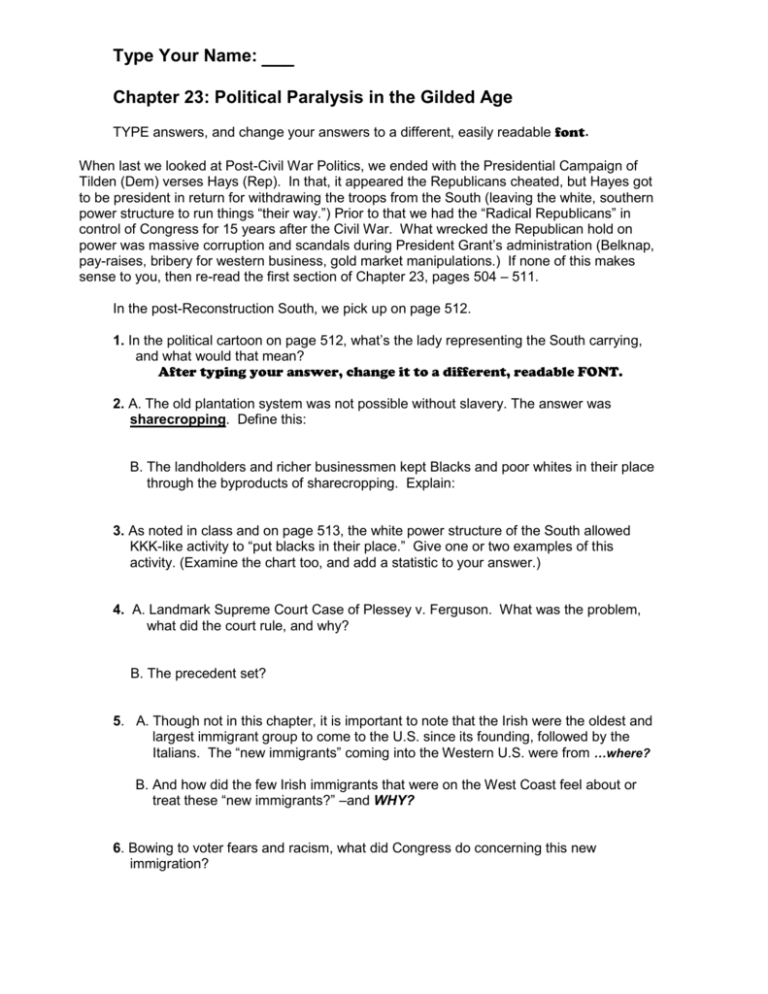
Type Your Name: ___ Chapter 23: Political Paralysis in the Gilded Age TYPE answers, and change your answers to a different, easily readable font. When last we looked at Post-Civil War Politics, we ended with the Presidential Campaign of Tilden (Dem) verses Hays (Rep). In that, it appeared the Republicans cheated, but Hayes got to be president in return for withdrawing the troops from the South (leaving the white, southern power structure to run things “their way.”) Prior to that we had the “Radical Republicans” in control of Congress for 15 years after the Civil War. What wrecked the Republican hold on power was massive corruption and scandals during President Grant’s administration (Belknap, pay-raises, bribery for western business, gold market manipulations.) If none of this makes sense to you, then re-read the first section of Chapter 23, pages 504 – 511. In the post-Reconstruction South, we pick up on page 512. 1. In the political cartoon on page 512, what’s the lady representing the South carrying, and what would that mean? After typing your answer, change it to a different, readable FONT. 2. A. The old plantation system was not possible without slavery. The answer was sharecropping. Define this: B. The landholders and richer businessmen kept Blacks and poor whites in their place through the byproducts of sharecropping. Explain: 3. As noted in class and on page 513, the white power structure of the South allowed KKK-like activity to “put blacks in their place.” Give one or two examples of this activity. (Examine the chart too, and add a statistic to your answer.) 4. A. Landmark Supreme Court Case of Plessey v. Ferguson. What was the problem, what did the court rule, and why? B. The precedent set? 5. A. Though not in this chapter, it is important to note that the Irish were the oldest and largest immigrant group to come to the U.S. since its founding, followed by the Italians. The “new immigrants” coming into the Western U.S. were from …where? B. And how did the few Irish immigrants that were on the West Coast feel about or treat these “new immigrants?” –and WHY? 6. Bowing to voter fears and racism, what did Congress do concerning this new immigration? 7. And in another Supreme Court Decision, this one concerning the families of the new immigrants, the 14th Amendment continued its huge reach into our society, and its ruling on this matter affects people in our current year. In a sentence, explain: More Crazy Presidential Politics. (Remember, Tilden v. Hays before? What follows shows just how screwed up things had become in the mid to late 1800’s.) 8. A. President Hayes is the incumbent, a Republican. What did his own party do? B. Name and party of the winner of this election of 1880? C. And how long did this 1880 Presidential winner serve? D. The name of the President that replaced him? 9. The by-product legislation of this deathly mess (in #8) was the end of the old “Spoils System,” also known as “patronage.” Define what the “spoils system” had been, and then tell what’s changed from pre1880 as compared to today. (Check out the caption under the cartoon on 515.) (Note the two quotes at the top of 518. These would be “documents” in a DBQ. Would you be able to understand what these men and their remarks are getting at in May, during the AP test?) 10. As a result of the President’s push for the aforementioned policy, what did the Republicans do about this President come next Presidential election (or rather, “nomination”)? 11. Then comes one of the dirtiest Campaigns in U.S. History, Blaine (Dem) against Grover Cleveland (Rep). In order to appeal to centrist Democrats and centrist Republican voters’ desire for honesty (after the last few administrations, the Democrats nominate the winner, .…who? The earth-shattering mud slung at this candidate (and eventual winner) was …what? (And yet he won anyway! --Wow. In my lifetime, that could not happen. I wonder if a guy who had Cleveland’s “problem” could be elected in the next elections? -Maybe if his mistake happened in his 20’s and he was running in his 50’s?) 12. Old Grover’s handling of the routine government Civil War pension bills? What did he do with such bills and what does this say about him? 13. As to the ever-repetitive tariff battle (and the sizable Government surplus of funds it continued to store), what did President Cleveland push for? 14. A. When you look at President Cleveland’s policies, the legislation he pushed for, and what the half-sentences the book devotes to his beliefs on government, with which party would President Cleveland identify with today? B. What about his alignment with Hamilton or Jefferson? In your answer to this question, name Hamilton’s and Jefferson’s political parties. (It’s a forced review; you’re welcome.) (And so, were the topic of more or less from the federal government come up on AP test, by all means, bring in the obscure President Cleveland!) And in all this, note how it had been impossible to tell what the major differences were in the 1880s (as well as through 1920) between the two political parties! What’s a Democrat vs. a Republican in 1880, 1884, 1892? --Though to tell… 15. A. What was the tax rate of the McKinley Tariff? B. Remember the anger of Southerners over the tariffs in the 1820’s – 1840? Remember why they were angry about them? The book (523) notes the same anger for American farmers over the McKinley Tariff. Explain: 16. A. (Page 523) These angry farmers unite and create a new political movement and party, whose name will stay with us for a 50 more years: B. Their platform is long, but succinct! –Thank goodness. It is too long to ask a question about, but reading it gives you the full flavor of what “Populism” is and what “Populists” are for the next half-century of history. The term still gets mentioned today when such legislation is proposed. The book notes their assault on capitalism, but they are by no means communist. How could you shortly phrase their character based on their platform? –Like two or three descriptive words? You flat-out have to know what populists were and what populism is. 17. The Populist candidate in the election of 1892 won over a million popular votes and many electoral votes! (Get it?—A 3rd Party won electoral votes!) But the Populists did not have anywhere near enough to win the Presidency, probably because they did not get any of the Southern vote. With the South massively agrarian, they should have sided with the Midwestern and the Western farmers for all the same reasons, and won the presidency. So, why didn’t they? 18. Throughout the birth of this Populist political action (pages 523 – 525) what ugly responses occurred in the face of organized labor strikes? (For AP, you are expected to name and know the Homestead Strike and the Pinkertons, and the U.S. Army action in the coal mine strike.) 19. And the Presidential winner of 1892? (Ok. Do you see why this is weird or unprecedented?) 20. This President’s “second” term, was marred by …what? 21. If you read page 527, you can see why we got rid of “The Gold Standard.” No, our money is not backed up by gold today. To shore up the lack of gold reserved in the Federal Treasury, what was Cleveland’s solution? And the Cleveland Administration will go down in Tariff betrayal, income tax mess, and more economic downturn… Bummer.
